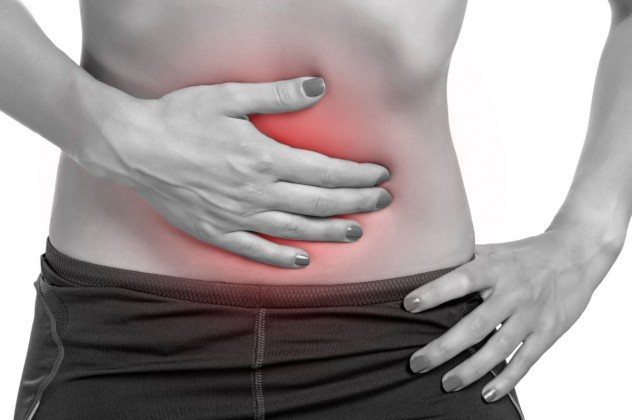Signs of high stomach acidity
Hydrochloric acid is secreted by the stomach and neutralized in its antrum for normal absorption of food in the intestine. When an imbalance develops in the production and neutralization of hydrochloric acid, increased acidity of the body appears. If excessive acid production occurs over a long period of time, a steady increase in acid occurs in the stomach and duodenum.
Symptoms of decreased acidity cannot be ignored; prolonged irritation of the gastric mucosa, especially in the presence of gastritis, is fraught with many concomitant diseases. Due to pathology, many digestive disorders develop:
- peptic ulcer of the stomach and duodenum;
- gastroduodenitis;
- gastroesophageal reflux disease;
- gastritis of various types.
Gastritis of the stomach
The following symptoms allow you to understand that acidity is increased:
- heartburn is a clear sign of diseases of the gastrointestinal tract, indicating this in combination with other signs;
- burning sensation in the chest area and sore throat;
- belching with a bitter taste;
- the pain is aching, paroxysmal, indicating the initial stage of development of ulcers;
- pain under the rib on the right side.
If you notice a number of symptoms, do not delay visiting your doctor. An increase in pH level is a dangerous dysfunction of the gastrointestinal tract; if it lasts for a long time, the consequences are irreversible.
Medical certificate

The acidity of the stomach, or more precisely, gastric juice, is an indicator characterizing the concentration of free hydrogen ions and hydrochloric acid in gastric juice or gastric contents in general. This indicator is measured in pH, which is an abbreviation for the Latin pondus hydrogenii, and translated as the weight of hydrogen. Regardless of the diagnostic test or method, the main indicator remains the study of the pH level.
In order not to get confused in terminology, you should remember a simple scheme: the lower the pH, the higher the acidity of the stomach and vice versa, the higher the pH, the lower the acidity of the gastric juice. Now you will understand what will be discussed.
Signs of low stomach acidity
It is possible to determine the acidity of the stomach, if it is noticeably reduced, independently. Then you will need to urgently contact a gastroenterologist to confirm the diagnosis. The doctor will diagnose problems in the gastrointestinal tract and prescribe the correct treatment. Low acidity is no less dangerous than high acidity and causes a number of characteristic phenomena.

Acidity in the stomach
The main symptom of a low pH level is bad breath, which has a putrid taste like a rotten egg. The beneficial properties of hydrochloric acid are that the substance has an antiseptic and bactericidal effect on pathogenic microorganisms. Harmful bacteria enter the body, gastric juice processes contaminated food, preventing poisoning from waste products. If there is not enough hydrochloric acid, protective reactions are reduced. In a similar way, viruses and bacteria enter the intestines, destroying beneficial microflora.
A frequent companion to low acidity is constipation, followed by frequent diarrhea. Intestinal upset occurs due to weakening of the protective mechanisms in the stomach; it is important to try to maintain the correct balance of acids in the body. The cause of constipation is deterioration of intestinal motor function due to lack of acid. The disorder cannot be corrected by diet or stimulating methods. Only a temporary effect will appear, since the root cause has not been eliminated.
Fermentation in the intestines causes discomfort, pain and flatulence. Proteins are absorbed in the intestines, resulting in incomplete absorption. An excess of breakdown products accumulates in the stomach, which have a negative effect on the body, causing intoxication. Toxins help reduce the body's resistance to viral diseases, and human immunity decreases. In combination with these symptoms, fungal infections of the mucous membranes, scalp, palms and feet are noted.
When protein metabolism slows down, decreased acidity leads to poorer absorption of vitamins and minerals. Vitamin deficiency is fraught with fragility and dryness of hair, skin, brittle nails and other external signs. Organs and systems suffer from vitamin deficiency. Vitamin deficiency is accompanied by iron deficiency anemia. Together with atrophic gastritis, anemia is considered a sign of Addison-Biermer disease. Autoimmune gastritis is accompanied by B12 deficiency anemia.
Among the external symptoms of low acidity are problems with the skin. A person has acne on the face and body, dilation of capillaries on the face. Undigested food remains are visible in the stool. After eating, a person experiences heartburn, bloating and heaviness in the stomach.
The Healthiest Drinks for Alkalinization
Recipes
The simplest is a glass of water (preferably warm) with a couple of tablespoons of lemon juice and a teaspoon of honey. It is better to drink this drink in the morning, on an empty stomach.
Berry infusions - from black currants, raspberries or rose hips - are also the most useful. Pour 250 ml of very hot water over a spoonful of berries (dry, fresh or frozen). Let it brew for 30 minutes and drink. You can sweeten it slightly with honey.
Also useful are teas (herbal from mint, chamomile, linden, lemon balm, or green), homemade juices with pulp - from fruits, berries, vegetables, and the same greens.
Reviews
Alkaline mineral water also gives a quick effect. You need to choose the one that contains more sodium, potassium salts, calcium, iron, magnesium. The most famous of these are Borjomi and Essentuki No. 4. By the way, they are great for helping with a hangover, when the body suffers from a lack of microelements.
A friend of mine tested the quick benefits of mineral water on himself. He felt unwell for a long time, but the doctors did not find any illnesses. Later, the doctor determined that there was an imbalance in the pH balance in the body. And my friend chose the optimal treatment for himself - mineral water. Its use in courses, in reasonable, therapeutic doses, as well as dietary reforms, gave an excellent result - the pH returned to normal.
How is stomach acidity determined?
A gastroenterologist knows how to reliably determine acidity in gastritis. They call indirect signs by which conclusions about a decrease or increase are made. Let's name a list of justified methods that determine acidity to the nearest tenth. Among the methods mentioned are:
- Determining the degree of staining of urine. Stomach acidity can be determined using ion exchange resins, for example, Gastrotest. Doctors have discovered that the sign is influenced by many subjective factors: the presence of urolithiasis, other diseases of the excretory system. The accuracy of the method is so low that it is practically not used in modern medicine.

- Fractional intubation of the stomach. Examination of the stomach contents occurs after suction with a rubber tube. Gastric juice is delivered to the laboratory in a sterile tube. Laboratory tests show the approximate pH level. But the method is not accurate enough. When taking gastric secretions, it mixes with substances from other parts of the gastrointestinal tract, causing distorted results. The method is unpleasant, disrupts the normal functioning of the stomach for some time, and negatively affects the patient’s health.
- The most informative research method aimed at determining the level of acidity is intragastric pH-metry. With the help of acidogastrometers with acidity level sensors, it will be possible to record the pH in all parts of the gastrointestinal tract at once. The method allows you to accurately judge the level of acidity in the body, contributes to the correct diagnosis and the prescription of correct treatment.
Deliberately false methods
The Internet is full of information on how to find out the acidity of the stomach at home using litmus paper. Due to the lack of free time and the desire to go to the doctor, a person is ready to believe in the most stupid diagnostic methods. The so-called “advisers” claim that you just need to moisten the litmus paper with saliva and wait for the color to change. Indeed, the paper changes its color. But the characteristics of saliva that have nothing to do with acidity play a role here.
Other “experts” say that they easily determined the level of hydrochloric acid using soda. It is enough to dissolve 2-3 tablespoons of the product in a glass of boiled water and drink it at a time. And then listen to the feelings. The procedure is performed in the morning on an empty stomach, but it is absolutely useless and uninformative.
And another dubious diagnostic method is related to the nature of belching. They say that the more intense and often it occurs, the more juice the stomach secretes. The statement is not entirely correct, since fluid production changes under certain conditions. For example, a person ate a lot of heavy food, overate, and so on. Because of this, intense belching can occur, but its connection with acidity is very doubtful.
Treatment of pathological acidity
If low acidity is detected in a patient with gastritis without the presence of erosive damage to the mucous membrane, the following drugs are prescribed:
- hydrochloric acid and medications that stimulate its production;
- to restore normal enzymatic function, replacement therapy with pepsidil is prescribed;
- depending on the symptoms, it is necessary to use medications with an antacid effect;
- If there is an infection with the bacterium Helicobacter pylori, antibiotic therapy is used.
At low pH levels, traditional medicine suggests eating plants with a bitter taste - peppermint, wormwood or calamus. The traditional method of fighting the disease is to follow the principles of dietary nutrition. Patients with gastritis are advised to avoid whole milk, grapes, apricots, and fresh baked goods, which cause fermentation processes in the intestines. It is important to abstain from fried, spicy, fatty, smoked foods. You need to eat small meals and avoid long breaks between meals.
All these principles must be followed at high pH levels. He is treated with medication according to the following scheme:
- prescription of antisecretory drugs that reduce the production of gastric juice;
- the use of antacid therapy for concomitant symptoms of gastritis;
- proton pump inhibitors that neutralize the effect of hydrochloric acid.
Timely measures will ensure successful normalization of the secretory function of the stomach and eliminate unpleasant symptoms. In the presence of chronic diseases of the gastrointestinal tract, it is important to be attentive to the quality and benefits of food, and promptly seek medical help when the first signs of exacerbation appear.
More about the diet
To answer the question of how to restore the acid-base balance in the human body, it is important to consider his diet.
Focus on greens and raw (or steamed) vegetables. The most effective in this regard are: spinach, asparagus, any kind of onion, broccoli, aromatic garlic, pumpkin, zucchini, avocado, red and white beets, celery, tomatoes, any other type of cabbage, carrots and parsley.
Fruits and berries will also help. Eat figs, papaya, melons.
Also eat oranges, grapefruits and other citrus fruits, mangoes, pears of any variety, kiwi and apples.
Don't forget about a variety of berries.
In addition, cherries, pineapples, bananas and peaches will be useful. Note that citrus fruits (even overly sour lemons) still belong to the “friendly” alkaline group for us. Therefore, they are also recommended to optimize balance.
Excellent results are given by: pumpkin seeds, honey, almonds, cold-pressed olive oil.











